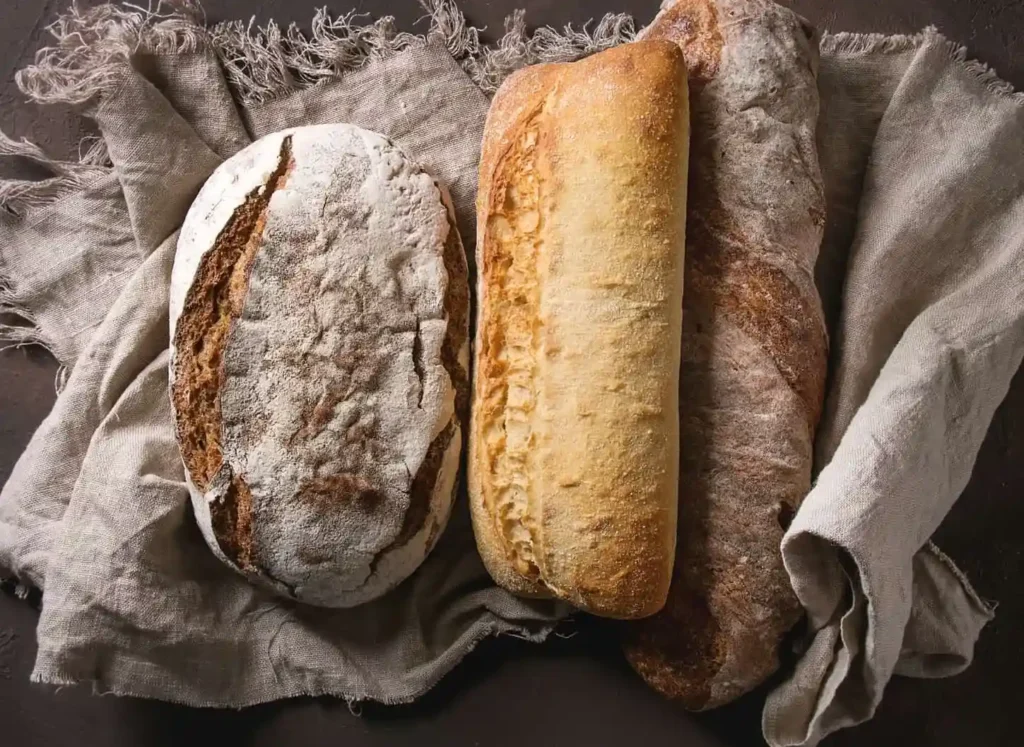
Troubleshooting Guide: 5 Reasons Your Bread Isn’t Browning and How to Fix It
Are you tired of pulling out pale and unappetizing loaves of bread from your oven? Don’t worry, you’re not alone. Achieving the perfect golden-brown crust on homemade bread can be tricky, even for experienced bakers.
But fear not, for I am here to help you troubleshoot the most common reasons why your bread isn’t browning and provide you with expert solutions to fix it.
In this comprehensive troubleshooting guide, we will explore five possible culprits behind your pale loaves and equip you with the knowledge and techniques to achieve that beautiful, crusty exterior you desire.
From incorrect oven temperature to improper dough hydration, we will delve into each issue and offer step-by-step solutions to help you achieve bakery-quality results every time.
Table of Contents
ToggleImportance of Achieving the Perfect Browning on Bread
Before we dive into the troubleshooting process, let’s take a moment to understand why achieving the perfect browning on bread is so important. The crust of a loaf of bread is not just about aesthetics—it plays a crucial role in the overall flavor and texture of the bread.
A well-browned crust adds depth and complexity to the taste, creating a contrast between the soft crumb and the crispy exterior. Additionally, a properly browned crust provides structural support to the bread, giving it a satisfying crunch when you bite into it.
So, whether you’re baking a simple loaf for sandwiches or a fancy artisanal bread, achieving that beautiful golden-brown crust is key to elevating your baking game to the next level.

Reason 1: Incorrect Oven Temperature
One of the most common reasons why bread fails to brown properly is an incorrect oven temperature. Baking bread at too low a temperature can result in a pale and underwhelming crust.
On the other hand, baking at too high a temperature can lead to burnt or overly darkened crusts. To ensure your bread browns evenly and to the desired degree, it’s important to accurately calibrate your oven temperature.
To fix an incorrect oven temperature, start by investing in an oven thermometer. Place the thermometer on the center rack of your oven and preheat it to the desired baking temperature. Once the oven reaches the desired temperature, check the reading on the thermometer.
If it doesn’t match the set temperature, adjust your oven’s thermostat accordingly. This step is crucial in achieving consistent and reliable results when baking bread.
How to Fix Incorrect Oven Temperature
To ensure your bread bakes at the correct temperature, follow these steps:
1. Preheat your oven with the thermometer inside to the desired baking temperature.
2. Adjust your oven’s thermostat based on the reading from the thermometer.
3. Once the oven reaches the desired temperature, remove the thermometer and place your bread inside.
4. Bake according to the recipe’s recommended baking time and temperature.
By accurately calibrating your oven temperature, you’ll have better control over the browning process and achieve more consistent results with your bread.
Reason 2: Insufficient Moisture in the Oven
Another common culprit behind pale bread is insufficient moisture in the oven. Steam plays a crucial role in bread baking, especially in the initial stages. The moisture generated from the dough and added steam helps create a humid environment, which promotes a good oven spring and contributes to a beautiful crust. Without enough moisture, your bread may not brown properly.
To increase moisture in the oven, there are several techniques you can employ. One simple method is to place a shallow pan of water on the lower rack of your oven while preheating. As the water evaporates during the baking process, it will create steam, ensuring your bread has the necessary moisture for proper browning.
Another technique is to spritz water onto the bread or the oven walls using a spray bottle before and during the baking process. This technique can be particularly effective when baking crusty artisan bread.
How to Increase Moisture in the Oven
Here’s a step-by-step guide to increasing moisture in your oven for better bread browning:
1. Place a shallow pan filled with water on the lower rack of your oven while preheating.
2. Preheat your oven as usual, allowing the water to evaporate and create steam.
3. Alternatively, use a spray bottle to spritz water onto the bread or the oven walls before and during the baking process.
4. Be cautious not to oversaturate the dough or create too much steam, as this can negatively affect the texture of the bread.
By incorporating these moisture-enhancing techniques into your baking routine, you’ll notice a significant improvement in the browning of your bread.
Reason 3: Overbaking
Believe it or not, overbaking can also lead to pale bread. When bread is left in the oven for too long, the crust can become dry and lose its ability to brown. This is especially true for lean doughs, which have lower fat content. Overbaking can also result in a burnt or overly darkened crust, which is equally undesirable.
To avoid overbaking your bread, it’s essential to closely monitor the baking time and temperature. Follow the recipe’s instructions carefully and make use of visual cues to determine when your bread is done. A properly baked loaf should have a deep golden-brown crust and sound hollow when tapped on the bottom.
Invest in a digital probe thermometer to check the internal temperature of your bread. For most bread, a target internal temperature of around 190-205°F (88-96°C) is ideal.
How to Avoid Overbaking
To prevent overbaking and achieve the perfect crust, follow these steps:
1. Set a timer according to the recipe’s recommended baking time.
2. Monitor the oven during the last few minutes of baking to avoid burning.
3. Use visual cues such as color and crust texture to determine when your bread is done.
4. Optionally, use a digital probe thermometer to check the internal temperature.
By mastering the art of timing and knowing when to take your bread out of the oven, you’ll be able to achieve a beautifully browned crust without the risk of overbaking.
Reason 4: Using the Wrong Type of Bread
The type of bread you choose to bake can also impact its browning potential. Different bread recipes have varying levels of sugar, fat, and hydration, which influence how the crust develops.
For example, enriched bread, such as brioche or challah, which contains eggs and butter, tends to brown more easily due to the higher fat content. On the other hand, lean bread, like baguettes or ciabatta, requires a different approach to achieve optimal browning.
When troubleshooting the lack of browning in your bread, consider experimenting with different recipes and adjusting the ingredients to find the right balance. Increase the fat content by adding butter, oil, or eggs to your dough, as this can enhance browning.
Alternatively, if you’re looking to achieve crusty artisan-style bread, lean dough with higher hydration and less fat can produce excellent results with the right techniques.
How to Choose the Right Type of Bread for Browning
To choose the right type of bread for optimal browning, follow these tips:
1. For a rich and golden crust, opt for enriched bread recipes that contain eggs and butter.
2. Increase the fat content in your dough by incorporating butter, oil, or eggs.
3. If you prefer a crusty artisan-style bread, choose lean dough recipes with higher hydration and less fat content.
4. Experiment with different recipes and adjust the ingredients to achieve the desired browning.
By selecting the appropriate bread recipe and adjusting the ingredients to suit your preferences, you’ll have better control over the browning process and achieve the desired results.

Reason 5: Not Using an Egg Wash or Glaze
One of the simplest yet most effective techniques for enhancing browning on bread is to use an egg wash or glaze. The proteins and sugars in the eggs contribute to a beautiful golden-brown color and a glossy finish.
An egg wash is typically made by whisking together eggs and a small amount of water or milk. For a richer color and a more pronounced shine, you can also add sugar or honey to the mixture.
To use an egg wash or glaze, simply brush it onto the surface of the bread before baking. This technique works especially well for soft, sandwich-style bread and enriched doughs. The egg wash not only promotes browning but also adds an attractive shine to your loaves.
How to Use an Egg Wash or Glaze for Better Browning
To use an egg wash or glaze to enhance browning, follow these steps:
1. Whisk together eggs, water, milk, and optional sugar or honey in a small bowl.
2. Gently brush the egg wash or glaze onto the surface of the bread before baking.
3. Bake the bread according to the recipe’s instructions.
By incorporating an egg wash or glaze into your bread-baking routine, you’ll achieve a beautiful golden-brown crust with an appetizing sheen.

Additional Troubleshooting Tips for Browning Bread
While the five reasons mentioned above are the most common culprits behind pale bread, there are a few additional tips that can help you troubleshoot and improve browning:
1. Use a baking stone or steel: Preheating a baking stone or steel in the oven can help create a more intense heat, promoting better browning.
2. Adjust oven rack position: Placing your bread on the lower rack of the oven can result in better bottom browning while moving it to the upper rack can enhance top browning.
3. Experiment with different baking times: Every oven is unique, and slight adjustments to baking times can make a significant difference in achieving the desired browning.
By incorporating these additional troubleshooting tips into your bread-baking routine, you’ll be able to further fine-tune your results and achieve the perfect browning every time.
Conclusion
In this comprehensive troubleshooting guide, we’ve explored the five most common reasons why your bread isn’t browning and provided you with expert solutions to fix it.
From incorrect oven temperature to improper dough hydration, we’ve delved into each issue and offered step-by-step solutions to help you achieve bakery-quality results every time.
By calibrating your oven temperature, increasing moisture, avoiding overbaking, choosing the right type of bread, and using an egg wash or glaze, you’ll be well on your way to baking picture-perfect loaves that are as delicious as they are visually stunning.
So, grab your apron, put on your baker’s hat, and start troubleshooting your way to golden-brown perfection. Happy baking!
Lindsey Mackenzie
About me
Hi there! I’m Lindsey Mackenzie, the founder of Bake Smartly. Baking has been my passion since childhood, growing up in my father’s bakery. With Bake Smartly, I’m excited to share my love for all things sweet and savory. Join me on this delicious journey as we whip up scrumptious treats and sprinkle joy into every bite!






